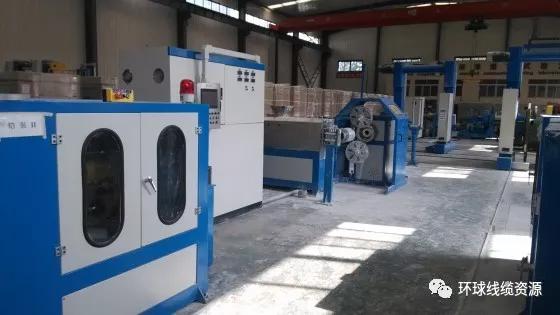 Continuous production line for longitudinal welding of cable copper strip
Continuous production line for longitudinal welding of cable copper strip
Abstract: This paper mainly introduces the equipment and process of copper strip longitudinal cladding welding continuous production line, which solves the problems of short cable length, shortening production cycle, reducing cost and improving production efficiency. The difference between rolling and drawing in the manufacture of mineral insulated cables is also introduced.
Key words: mineral insulated cable; Equipment; Material Science; Production process; Technical data; Rolling and drawing;
1. Overview
Mineral insulated cable (MI), also known as magnesium oxide insulated cable, is a kind of inorganic material cable. Mineral insulated cable is made of copper conductor, inorganic insulating material (magnesium oxide powder) and seamless copper tube or copper strip longitudinally wrapped and welded into seamless copper tube after multiple drawing or rolling. This unique structure makes it fire resistant, explosion-proof, high temperature resistant, non aging, non fire causing and fire spreading, and will not release any harmful gas and smoke under the surrounding fire conditions. It is especially suitable for places or parts with harsh environment and high safety requirements, especially for the fire control system lines that need to ensure safe power supply under fire conditions. If necessary, a layer of polyethylene sheath or low smoke halogen-free sheath can be extruded on the metal sheath. Mineral insulated cables can be divided into distribution cables, heating cables and heating elements, thermocouple cables and compensation cables, and special cables according to different purposes. In practical applications, the most commonly used is distribution cables,
At present, the national standard for mineral insulated cables is GB/T13033.1-2007. In addition to the national standard, a new type of mineral insulated special cable has emerged - - 825 alloy sheathed mineral insulation Fireproof cable 。 825 alloy sheathed mineral insulated fireproof cable is specially designed for normal operation (power transmission) under hydrocarbon explosion flame and highly corrosive environment. The cable consists of one or more conductor cores, magnesium oxide powder and 825 alloy sheathed. The conductor core is generally nickel clad copper or pure nickel solid core. The outer sheath of 825 alloy cable cannot be used as grounding wire. 825 alloy has resistance to acid and alkali metal corrosion in both oxidation and reduction environments. High nickel content makes the alloy have effective resistance to stress corrosion cracking. It has good corrosion resistance in various media, such as sulfuric acid, phosphoric acid, nitric acid and organic acid, and alkali metals such as sodium hydroxide, potassium hydroxide and hydrochloric acid solution. 825 alloy is so far found to have excellent performance in all aspects in the environment where organic sulfide, hydrogen sulfide and sulfur combustible products are produced at high temperature (such as petroleum and petrochemical units). The 825 alloy sheathed mineral insulated fireproof cable can not only survive for 30 minutes in the high temperature explosion flame at 1200 ℃, but also has strong corrosion resistance to petroleum gas and acid mist. The test was conducted by Exxon Mobil Oil Company. The 825 alloy cable was placed in an environment very similar to the actual hydrocarbon explosion fire. The test procedure stipulates that the tested cable must be supported in a pit filled with gasoline and diesel mixture. When the mixture is ignited, the temperature in the furnace will rise sharply and burn violently. In the test, the tested cable sample not only withstands the high temperature of the flame, but also has destructive turbulent fire. During the whole test, the average temperature exceeded 1100 ℃. Due to the characteristics of the test itself, the temperature fluctuated up and down at the 1100 ℃ level. The test shows that the cable can continue to work normally in case of fire.
2 Equipment diagram
2.1 Double copper tape paying off device:
Structure: the double copper belt pay off device is a pay off machine with two independent pay off rods and brake air brake. Two independent paying off rods can be rotated, and the diameter of each paying off rod is within (240-470) mm. The maximum width is 320mm, and the length of each of the four support strips beside is 600mm. The maximum weight of copper strip (all)=1400 kg, and 60.5 mm wide copper strip is commonly used (the maximum weight of each reel can reach 700 kg)
Function: to maintain a certain tension between the copper tape paying off machine and the copper tape accumulator. The advantage of copper tape stringing machine is that. When one coil of copper strip is used up, replace another coil of copper strip to weld with it without stopping the machine (argon is used as shielding gas, and UTP silver electrode is filled with argon arc welding) to ensure continuous production of the production line.
(Double copper tape paying off device)


